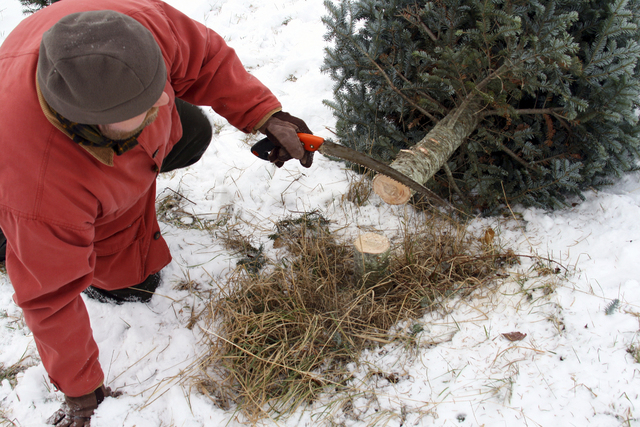Create treasured memories with a tree-cutting adventure
Most Americans never experience the traditional trek to the woods to cut the family Christmas tree. It is familiar only through nostalgic holiday cards.
A drive to the temporarily forested tree lots that appear seasonally is as close as most of us come to that festive experience.
The tradition survives in parts of the country where commercial tree plantations allow customers to choose a tree and cut it themselves, and in Western states where tree cutting is allowed on forested public lands.
Both the Bureau of Land Management and the U.S. Forest Service start selling tree-cutting permits in November. Since no cutting is allowed in Clark County, the closest in-state cutting areas for Southern Nevadans will be in parts of Lincoln and White Pine counties. However, cutting areas in Southern Utah and Northern Arizona are much closer.
The BLM charges $5 for a permit, with a limit of five permits per person. Trees from BLM lands will be pinyons or junipers. Forest service permits cost $10 per tree up to 10 feet tall and $20 for trees 11 to 20 feet tall. Trees permitted for cutting in national forest areas include pinyons, junipers and certain varieties of higher-elevation fir trees.
When you purchase the permit, you will receive maps of cutting areas, illustrations of the types of trees to be cut and details on how to cut and care for your tree. Cutting areas are often located off gravel side roads that may require the use of a high-clearance vehicle. Be prepared for cold temperatures and possible snow. You will need an ax, a suitable saw or a gas-powered chain saw. After acquiring the proper equipment and buying the permit, gas and food for the trip, the tree you cut won’t be cheap. But the holiday memories will be priceless.
Tree permits are available by mail, but most tree cutters pick them up at agency offices or cooperating businesses near cutting areas. For Nevada cutting area permits, check with BLM or Forest Service offices locally.
Permits for the closest Utah and Arizona BLM and national forest areas are available in St. George, Utah, at the interagency visitor center on Riverside Drive. Permits are also available at the Veyo Mercantile on state Route 18 for the Pine Valley area. High elevation areas where fir trees may be cut are apt to be located in Kaibab National Forest in Arizona or in Dixie National Forest near Cedar City. Check in St. George for the Arizona cutting sites. For Dixie National Forest, check at the agency office in Cedar City or at the local Ace Hardware.
Your search for the perfect tree may lead you some distance from your vehicle, so keep an eye on landmarks that will help you find your way back. Whatever tool you use to cut down your tree, make sure it is sharp and in good repair. Leave a stump of less than 6 inches and remove side branches. Attach the permit to the trunk of the tree.
Everyone in your party should dress in warm layers, keep hands warm and heads covered and have rugged footwear. Pack a few warm blankets and a change of shoes and socks or cozy slippers. Bring drinking water. Hearty snacks and warm soups and beverages make welcome tailgate fare.
Keep your tree fresh with good care. When you get it home, wash the tree down with a hard spray from a hose. Recut the base and immediately stand it in water in a sheltered place until you are ready to use it.
When the tree comes inside, set it up in a stand with a water basin on a plastic tarp. Replenish the water frequently. The tarp will protect the flooring and allow you to maneuver the tree into place after you get the lights on it. Tuck it close to the tree and conceal with a tree skirt or snowy sheet. The tarp will also catch needles and make removal easier.
The tree you get yourself will be the freshest you’ll ever decorate and its woodsy scent will perfume memories of the family tree-cutting adventure.
Margo Bartlett Pesek’s column appears on Sundays.






















